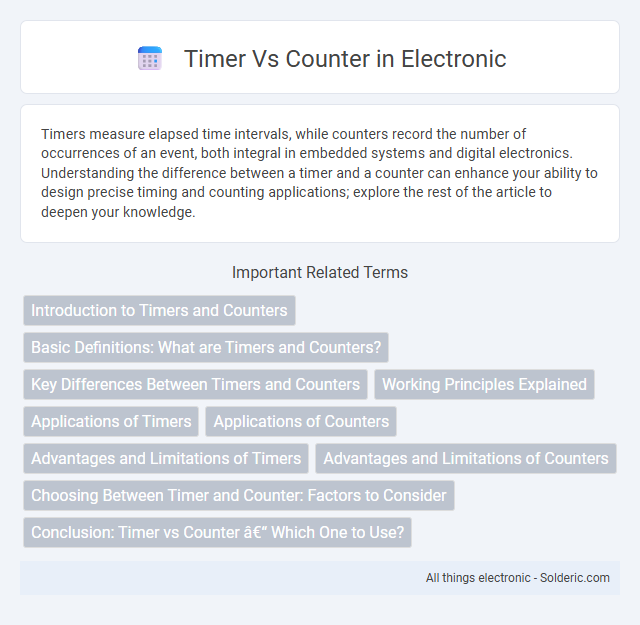Timers measure elapsed time intervals, while counters record the number of occurrences of an event, both integral in embedded systems and digital electronics. Understanding the difference between a timer and a counter can enhance your ability to design precise timing and counting applications; explore the rest of the article to deepen your knowledge.
Comparison Table
| Feature | Timer | Counter |
|---|---|---|
| Primary Function | Measures time intervals | Counts external events or pulses |
| Input Source | Internal clock or oscillator | External signal or pulse |
| Application | Delays, time measurement, scheduling | Event counting, frequency measurement |
| Trigger | Internal timer start | External pulse detection |
| Operation Mode | Time-based | Event-based |
| Usage Example | Generating time delays in microcontrollers | Counting products on assembly lines |
Introduction to Timers and Counters
Timers and counters are essential components in microcontrollers used for precise time measurement and event counting. A timer measures elapsed time based on the clock pulses, while a counter tracks the number of external events or pulses. Understanding how your device's timer and counter modules work can optimize its performance in applications like frequency measurement or time delay generation.
Basic Definitions: What are Timers and Counters?
Timers are hardware or software components that measure time intervals by counting clock pulses, enabling precise timing operations in embedded systems and microcontrollers. Counters, on the other hand, track the number of events or external pulses, useful for applications requiring event counting or frequency measurement. Understanding the distinct roles of timers and counters helps you select the right component for timing or counting tasks in your project.
Key Differences Between Timers and Counters
Timers measure elapsed time intervals by counting clock pulses from a known frequency source, primarily used for time-delay generation and event scheduling. Counters, on the other hand, count external events or pulses, incrementing or decrementing based on input signals to quantify occurrences or frequency. The fundamental difference lies in timers operating based on internal clock cycles for time measurement, whereas counters rely on external input signals for event counting.
Working Principles Explained
A timer operates by measuring specific time intervals using an internal oscillator or clock source, enabling precise event scheduling or delays in microcontroller applications. A counter, on the other hand, increments or decrements its value based on external input pulses, effectively counting occurrences of external events or signals. Both mechanisms rely on registers and clock signals but differ fundamentally in their input triggers and primary functions within embedded systems.
Applications of Timers
Timers are essential in applications requiring precise time measurement and event scheduling, such as generating delays, timeouts, and pulse-width modulation (PWM) signals. Your embedded systems often use timers for periodic interrupts to manage tasks like sensor sampling, communication protocols, or real-time clock functions. In industrial automation, timers control processes by triggering actions after specific intervals, ensuring accurate operation timing and synchronization.
Applications of Counters
Counters are integral in digital electronics for applications such as event counting, frequency measurement, and digital clocks. They are used in devices like traffic signal controllers, pulse generators, and digital odometers to track occurrences of discrete events reliably. Your system can leverage counters for precise monitoring and timing functions essential in automation and embedded systems.
Advantages and Limitations of Timers
Timers offer precise control over time intervals, enabling accurate scheduling and delay management in embedded systems. Their ability to generate interrupts at fixed rates enhances multitasking and real-time application performance. However, timers are limited by clock resolution and can consume significant processor resources, potentially affecting overall system efficiency.
Advantages and Limitations of Counters
Counters offer precise event counting capabilities essential for applications requiring accurate measurement of occurrences, such as frequency measurement and digital event tracking. Their advantage lies in high reliability and minimal CPU interruption, enabling efficient processing of rapid signals. However, counters are limited by their maximum count value, which can lead to overflow issues in long-duration measurements, and they may require additional hardware resources compared to software timers.
Choosing Between Timer and Counter: Factors to Consider
Choosing between a timer and a counter depends on the specific application requirements such as measurement precision and event frequency. Timers are ideal for generating precise time delays and measuring intervals, while counters excel in counting discrete events or pulses. Consider factors like input signal characteristics, resolution, and desired output when selecting between these two for optimal performance in embedded systems.
Conclusion: Timer vs Counter – Which One to Use?
Timers are ideal for measuring precise time intervals in applications requiring consistent delays or pulse generation, while counters excel in counting external events or frequency measurement tasks. Selection depends on the specific use case: choose timers when time tracking is critical, and counters when event quantification or input signal counting is necessary. Embedded systems often integrate both functionalities to leverage their complementary strengths for comprehensive control and measurement.
Timer vs Counter Infographic

 solderic.com
solderic.com